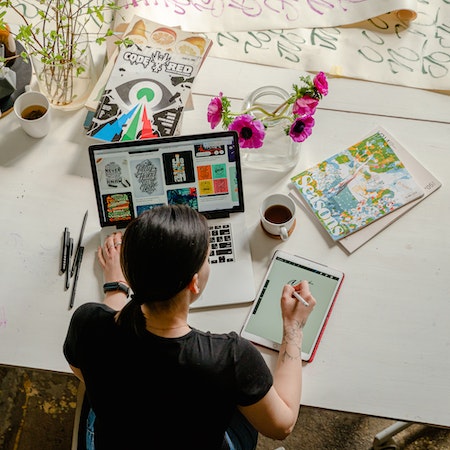Creating a logo is a creative process that involves designing a visual representation of your brand or organization. To create a logo, follow these general steps:
1. Define Your Brand:
Before you start designing, it's essential to have a clear understanding of your brand's identity, values, and target audience. What message do you want your logo to convey? Understanding your brand's personality and mission will guide the design process.
2. Research:
Look at logos from similar businesses or organizations to gather inspiration. Analyze what works and what doesn't. This research will help you identify trends and styles that resonate with your brand.
3. Sketch Ideas:
Start by sketching rough ideas on paper. These initial sketches don't need to be perfect; they're a way to brainstorm and visualize concepts. Try different shapes, typography, and symbols that relate to your brand.
4. Choose a Style:
Decide on the style of your logo. There are various logo styles, including wordmarks (text-based), lettermarks (initials), pictorial marks (symbols), and combination marks (a mix of text and symbols). Select the style that aligns with your brand's identity.
5. Color Selection:
Colors have a powerful impact on perception. Choose a color scheme that reflects your brand's personality. Ensure that the colors are visually appealing and suitable for various applications.
6. Typography:
If your logo includes text, select appropriate fonts. Consider the readability and compatibility of the fonts with your brand's image. Custom fonts can add uniqueness to your design.
7. Create Digitally:
Once you have a rough sketch and a clear idea of your design, you can use graphic design software (such as Adobe Illustrator or Canva) to create a digital version of your logo. Ensure that your logo is scalable and looks good in different sizes.
8. Simplicity and Versatility:
A good logo is simple and versatile. It should work in various applications, from business cards to billboards. Avoid complex designs that may lose their impact when scaled down.
9. Test and Refine:
Show your logo to colleagues, friends, or potential customers and gather feedback. Make necessary revisions based on their input. Sometimes, small adjustments can make a big difference.
10. Finalize and Save:
Once you're satisfied with your logo design, save it in different formats (e.g., PNG, JPEG, SVG) for various applications. You may also need to create versions with transparent backgrounds.
11. Legal Considerations:
Check for any trademark or copyright issues associated with your logo. Ensure that your design is unique and not already in use by another entity.
12. Implement:
Start using your new logo on your website, social media profiles, business cards, marketing materials, and anywhere else it's relevant. Consistency in branding is key to creating a strong visual identity.
Remember that creating a logo is a creative process, and it may take several iterations to arrive at the perfect design. If you're not confident in your design skills, consider working with a professional graphic designer who can help you bring your vision to life.








